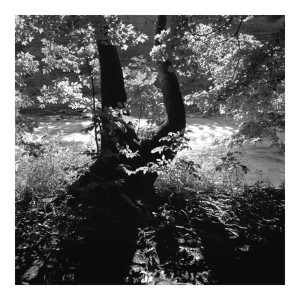Tourists takes tourist photos which are limited, inevitably, to shots of features—mountains, shores, bays, sunsets, waterfalls, architecture, the list seems endless—to which they are attracted because they aren’t accustomed to them in their familiar environments. What they see are only the most salient features of where they are, often made so by commercialization. One must inhabit a landscape over time, perhaps for a lifetime, if one is to photograph its true character.
I have lived along the south shore of lake Erie for forty years, the last twenty in an inner ring suburb of Cleveland that abuts the Cleveland Metroparks Rocky River reservation. From my back yard I can step down to Coe Creek and follow its soggy path for a quarter mile to the river itself. This is the reality with which I am familiar.
The Rocky River reservation runs for thirteen miles through layers of clay, shale and gray sandstone from the river’s mouth in lake Erie to a tumbling water fall in Berea, Ohio. Beyond that, the park becomes the Mill Stream Run reservation, another part of the countywide parks system locals call the Emerald Necklace. The level of the river changes dramatically because of late winter thaws, soaking spring rains and summer thunderstorms. But in all seasons, if one is patient, it is possible to walk those thirteen miles in the river itself. When the river is high, bridle paths and hiking trails too numerous to count along the riverbanks offer alternative routes through the dense deciduous forest. The Rocky River, my home, is a photographer’s paradise.
Over the years, I have covered these thirteen miles in small increments more times than I can remember. A typical excursion for me is a three or four hour walk actually in or beside the river during which I may take five or six shots. Early on I carried a Toyo 4×5, then graduated to a vintage Deardorff 8×10. Camera, tripod, film carriers and lenses together weigh forty pounds or more, so I carry an Amish oak cattle prod as a walking staff to help with balance in the rough terrain. In the beginning I walked in the morning on the unquestioned assumption that morning light is the most flattering. Ten years later, it occurred to me to walk in the afternoon and I saw for the first time an entirely different landscape. Around the summer solstice when light is most abundant, I walk at midday when the cover is thickest, the shadows deepest, and the effects most dramatic.
High water in the river is a light caramel color, heavy with silt. It reflects nothing of the sky but clears quickly as the level falls. Then it becomes what Thoreau, in Walden, calls skywater. Low water is ge nerally a pale yellowish green and so transparent that sluggish carp and weary steelhead are perfectly visible in the pools and currents. The bed is variously gravel, tumbled boulders, fractured sandstone, or delicate mosaics of shale. In season, algae soften the contours of the riverbed. And then, of course, there is the long season of ice, from sheets as fine as mica to great slabs riding up the backs of other great slabs in the current at the river’s mouth.
nerally a pale yellowish green and so transparent that sluggish carp and weary steelhead are perfectly visible in the pools and currents. The bed is variously gravel, tumbled boulders, fractured sandstone, or delicate mosaics of shale. In season, algae soften the contours of the riverbed. And then, of course, there is the long season of ice, from sheets as fine as mica to great slabs riding up the backs of other great slabs in the current at the river’s mouth.
It is never easy walking. When tired, I can find a fallen tree to sit on. They are everywhere in the woods. If one sits quietly enough, one begins to notice a dying tree teems with life. Both flora and fauna congregate there, from the tiniest insects transforming the wood into a spongy hummus, to the white tale deer that browse on the wild flowers springing from the moss underfoot. A fallen tree is the scene of a feeding frenzy—fungus, insects, worms, birds, snakes, voles, mice, squirrels, raptors, all dining in succession on the tree and each other. And that’s just during the day. Raccoon, opossum and coyote scat shows the feasting continues unabated at night.
I often wonder how much of this anyone really sees. Most people who pass through this environment seem to have an agenda: taking a short cut to the freeway, monitoring their calorie burn, improving their split times as they train for a marathon. The majority of tourists to Cleveland don’t see this landscape at all, unless it is through the tiny window of a plane landing at Hopkins International. They are much more likely to ride the rapid downtown, take a photograph of the Rock and Roll Hall of Fame to show their friends and family at home. “Look,” they might say. “This is what I saw in Cleveland.”
“Toward the Light” is my portfolio of the Rocky River. It is what someone familiar with Cleveland sees.
Categories